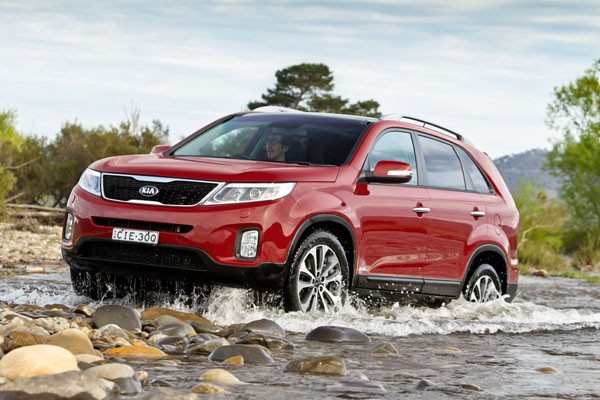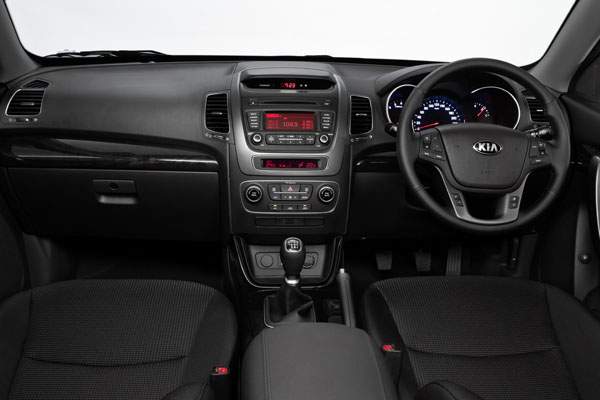 A month after the release of its Hyundai seven-seat Santa Fe SUV cousin, Kia’s 2013 Sorento has arrived in Australian dealerships.
A month after the release of its Hyundai seven-seat Santa Fe SUV cousin, Kia’s 2013 Sorento has arrived in Australian dealerships.
While at first glance exterior styling changes appear minimal, under the skin there’s a raft of upgrades that have improved the big Korean no end.
That said, so far as its persona is concerned, there are new headlights and LED daytime running lights and new-look LED taillights as well as a redesigned grille and tailgate and new bumpers and wheels.
The new Sorento rides on Kia’s interpretation of the new Santa Fe’s platform and engineers have used new ultra-high-tensile steel to endow the car with greater rigidity and enhanced crash protection for its occupants.
 Kia says an 18 per cent boost in torsional rigidity has refined the ride comfort and improved its handling.
Kia says an 18 per cent boost in torsional rigidity has refined the ride comfort and improved its handling.
Adding to the handling improvements are various design and engineering tweaks to the MacPherson-strut front and multi-link rear suspension set-ups and upgraded cross-members.
Over the years both Kia and Hyundai received their share of criticism about poor handling. To their credit, both companies have taken the negative reviews on board and these days they put a great deal of time, money and effort into local testing and tuning their underpinnings for Australian conditions.
In Kia’s case, suspension engineering wiz Graham Gambold has worked closely with Australian and Korean engineers and product-planning people on setting up vehicles for this market. Stronger sub-frames, beefier anti-roll bars and dual-low dampers have been fitted and like the new Santa Fe, the motor-driven power-steering has three settings – normal, sport and comfort modes.
Unlike its Santa Fe cousin which is a 4WD-only vehicle, the buyers of the new Sorento can opt for a 2WD petrol version.
Kia says that Ford and Toyota have found that more than 50 per cent of their Territory and Kluger sales are 2WD models – a clear demonstration that there is a significant market – especially in urban areas – for large family SUVs.
At launch, the new Sorento is available with two engine choices – one petrol and one turbo-charged and inter-cooled diesel. A 141 Kw/242Nm 2.4-litre direct-injected four-cylinder petrol engine could be added down the track.
The 2.2-litre turbo-diesel is good for 145 kW of maximum power at 3800 rpm and 421 Nm of peak torque (manual) and 436 Nm (automatic) that is on tap between a lazy 1800 and 2500 rpm.
A new exhaust-gas recirculating system has cut CO2 emissions from 177 g/km to 153 g/km and Kia claims a combined fuel-consumption figure of 6.6 litres/100 km for the manual version and 7.3 litres for the automatic
The 3.5-litre V6 petrol engine delivers 9.8 L/100km and its power and torque figures are 204 kW at 6300 rpm and 335 Nm at 5000 rpm respectively.
The transmission for all models bar one is the Hyundai/Kia group’s excellent sequential-sports-shifting automatic. The exception is the 2.2-litre diesel Si six-speed manual 4WD.
One of the good-news stories for the new Sorento’s passengers is that Kia’s clever designers have been able to give second-row seat occupants another 30 mm of leg room and those in the third-row pews can stretch out another 9 mm.
As well as boasting a stronger body shell that means better front, side and rear impact protection, all models come with dual front airbags, front side airbags and side-curtain airbags for front- and second-row occupants).
Standard too is Kia’s vehicle-stability management system that bundles stability control, traction control, ABS anti-lock brakes, electronic brake-force distribution, brake assist, hill-start assist and downhill brake control.
Also standard are front-and-rear parking sensors while the SLi and Platinum variants add a reversing safety camera with a 130-degree wide-angle lens. Platinum models also gain active HID (high-intensity discharge) Xenon headlights.
Bigger (320 mm) ventilated front discs and the carried-over 302 mm rear discs have improved the Sorento’s stopping power and Kia claims that if the driver jumps on the brakes at 100 km/h, the big SUV will stop in an impressive 36.3 metres.
Out on the road both the petrol and diesel versions are surprisingly spirited vehicles and hills and rapid overtaking are dispatched with ease.
Irrespective of which engine is under the bonnet, one of the first things you notice is how quiet the Sorento’s cabin is. This is the result of a great deal of work by Kia engineers to cut noise, vibration and harshness levels.
While the front seats are comfortable enough, a bit more thigh bolstering would be handy – especially for the leather-trimmed Sli and Platinum versions during enthusiastic cornering on winding roads.
Speaking of cornering, the newly tweaked suspension settings delivers flat, confident cornering and precise turn-in and while the motor-driven power-steering system’s ‘Sport’ mode is great during highway cruising, we found ‘Normal’ to be a better bet on the twisty bits.
Family buyers will welcome not only the seven-seat capacity but a raft of storage cubby holes and a cargo space that, depending on the second- and third-row seats are occupied or folded flat, ranges from 258litres to a whopping 2700litres.
Split-folding second- and third-row seats add greatly to the Sorento’s cargo flexibility.
A maximum safety rating helped along by driver- and front-passenger airbags, front side airbags, curtain airbags active front head restraints and other safety goodies combine to make the new Sorento an extremely safe family chariot.
Like virtually everything from Korea these days, the Sorento – even the entry-level Si version – comes with an impressive standard-kit inventory.
Active driver aids include Kia’s vehicle stability management system with electronic stability control, traction control, ABS brakes, electronic brakeforce distribution, brake assist, hill start assist and downhill brake control.
While on the subject of brakes, the Sorento has one of those horrible foot-operated parking brakes.
All three versions have front-and-rear parking sensors and both SLi and Platinum models add a reversing safety camera with a 130 degree wide-angle lens. The Platinum also gains active high intensity discharge Xenon headlights.
Alloy wheels ranging from 17-inch versions on the Si to 19s on the top-spec Platinum are fitted and each has a full-size alloy spare.
Other across-the-range standard features include cruise control, a leather-wrapped multi-function steering wheel and shift knob, a six-function trip computer, remote central locking with keyless entry and tailgate release, power windows and exterior mirrors, nice big sun visors with pull-out extenders, dual-zone climate-control air and tinted glass.
All models come with an MP3-compatible, six-speaker CD/AM/FM audio system, AUX/USB input and iPod compatibility, Bluetooth functionality for phone and media streaming. The list goes on and on and for the top-spec Platinum there is a huge panoramic sunroof, satellite navigation and climate-controlled front seats.
In summary, it’s surprising how much better the new facelifted Sorento is than its look-alike predecessor.
It’s a quieter, more comfortable, more handsome, roomier and better-handling vehicle that offers value-for-money family motoring.
The complete 2013 Kia Sorento range is:
Si 3.5-litre petrol 2WD five-door wagon: $37,490 (automatic)
SLi 3.5-litre petrol 2WD five-door wagon: $40,490 (automatic)
Si 2.2-litre turbo-diesel 4WD five-door wagon: $38,990 (manual), $40,990 (automatic)
SLi 2.2-litre turbo-diesel 4WD five-door wagon: $43,990 (automatic)
Platinum 2.2-litre turbo-diesel 4WD five-door wagon: $50,390 (automatic)
Note: These prices do not include government or dealer delivery charges. Contact your local Kia dealer for driveaway prices.











